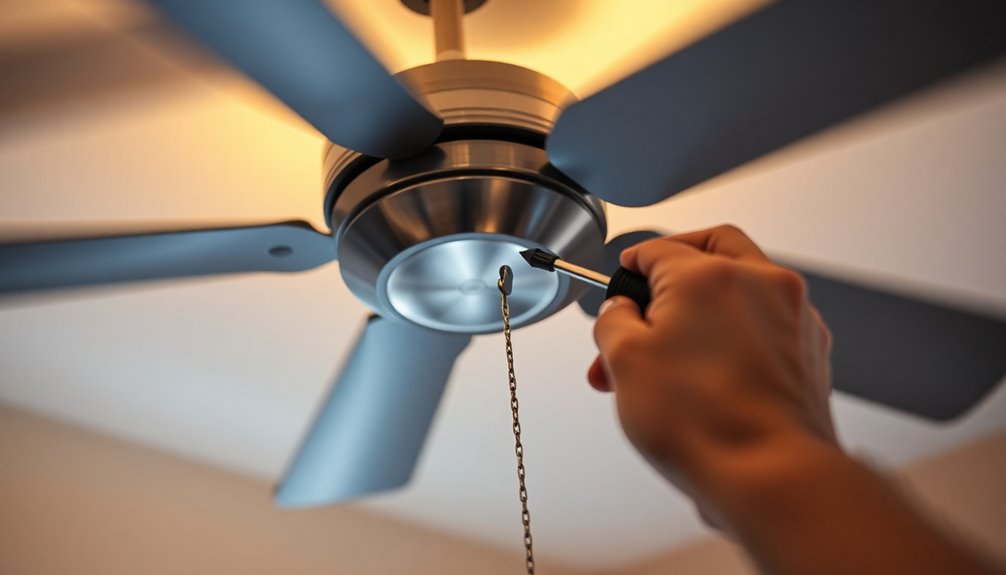If your ceiling fan turns on by itself, it is crucial to troubleshoot the issue. Start by checking the remote control's batteries and reprogramming it. Inspect wiring connections for any loose or damaged elements that might cause erratic behavior. Consider nearby devices that could interfere with the remote signal. If problems persist, you might have a defective switch or even wiring issues, which often require professional help. Always prioritize safety by turning off the power before inspecting. Keep an eye on your fan's performance to catch problems early, and you'll uncover additional insights on maintaining your fan effectively.
Key Takeaways
- Check for nearby devices that may interfere with the fan's remote control signal to prevent accidental activation.
- Inspect all wiring connections for looseness or damage, ensuring a secure and stable power supply.
- Replace remote control batteries regularly and examine the remote for any signs of wear or damage.
- Look for environmental factors, such as extreme temperatures, that might disrupt the fan's electronic components.
- If issues persist, consider consulting a professional electrician to evaluate potential electrical problems.
Common Causes of Activation
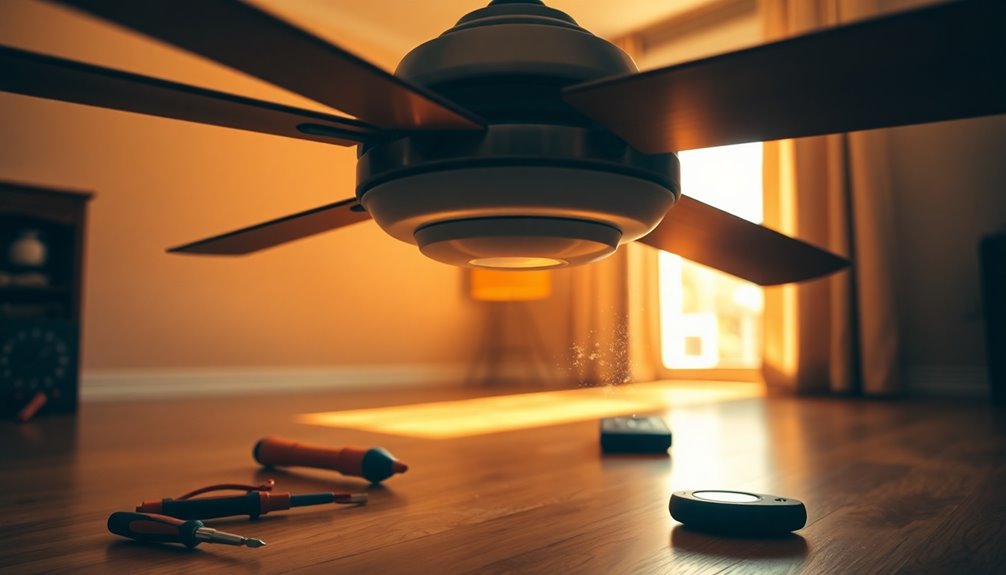
When it comes to ceiling fans unexpectedly turning on, several common causes can be at play. One possibility is neighboring interference, where remote controls operating on similar frequencies inadvertently activate your ceiling fan.
If you've noticed random activations, faulty wiring or loose connections within the fan assembly might lead to an intermittent power supply, triggering the fan without your command.
A defective switch, whether it's a pull switch or wall switch, can also malfunction, causing the fan to activate unexpectedly.
Power surges present another risk; sudden spikes in electricity can turn on electronic devices, including your ceiling fan.
Additionally, environmental factors like extreme temperature changes can affect the electronic components of your fan, leading to unintended activation.
If the temperature fluctuates considerably, it could disrupt the fan's normal functioning.
Troubleshooting Steps
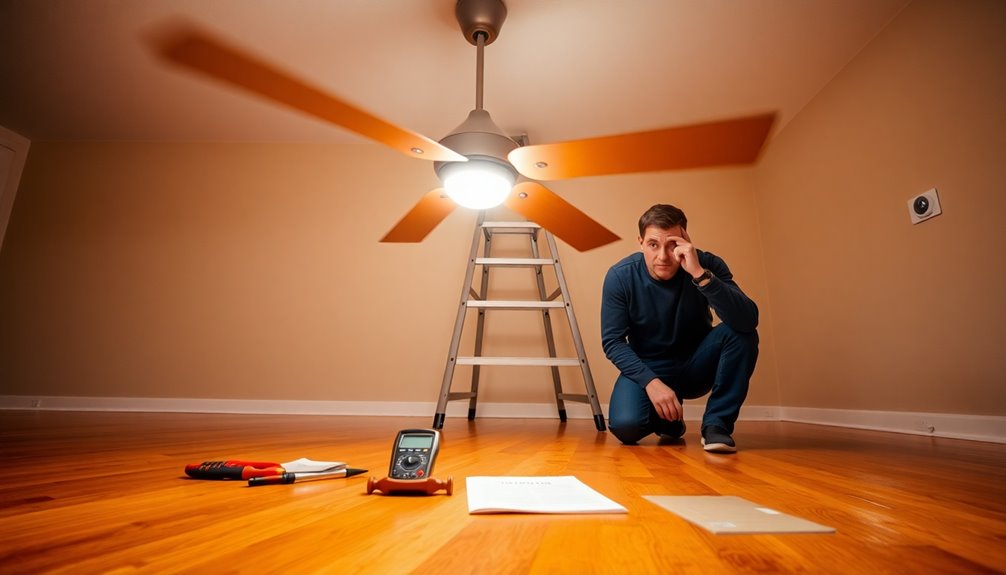
To start troubleshooting your ceiling fan, check the remote control batteries first; dead batteries can lead to unexpected behavior.
Next, inspect the wiring connections to guarantee everything's securely in place.
These initial steps can help you pinpoint the issue before moving on to more complex solutions.
Check Remote Control Batteries
One of the simplest yet most effective troubleshooting steps is to check the remote control batteries. Low or dead batteries can lead to erratic fan behavior or even cause your ceiling fan to turn on by itself.
Make certain you're using fresh alkaline batteries, as they typically offer better performance and a longer lifespan. When you replace the batteries, verify they're installed correctly, aligning the positive and negative terminals as indicated.
If your fan still operates unexpectedly after changing the batteries, look for any nearby devices that might cause interference with the remote signal. Additionally, inspect the remote control for signs of damage or wear. A malfunctioning remote can greatly impact your fan's operation.
Should replacing the batteries not resolve the issue, you might need to take into account reprogramming the remote. This guarantees it's correctly synced with your fan's receiver, which can help restore normal functionality.
Inspect Wiring Connections Securely
A thorough inspection of your ceiling fan's wiring connections is essential for guaranteeing safe and reliable operation. Loose or frayed wires can cause intermittent power supply, leading to your fan turning on by itself.
To tackle this issue, follow these steps:
- Turn off the power: Before you start, always cut the power to the fan at the circuit breaker to prevent electrical shock.
- Inspect the wiring: Look for visible signs of wear, corrosion, or overheating. Damaged wiring can indicate electrical issues that may lead to malfunctions.
- Test with a multimeter: Use a multimeter to check for continuity in the wiring connections. This will help you determine if electricity is flowing correctly and identify any breaks or shorts in the circuit.
After securing any loose connections, restore power and test the fan. If the problem persists, further investigation may be necessary.
Preventive Maintenance Tips
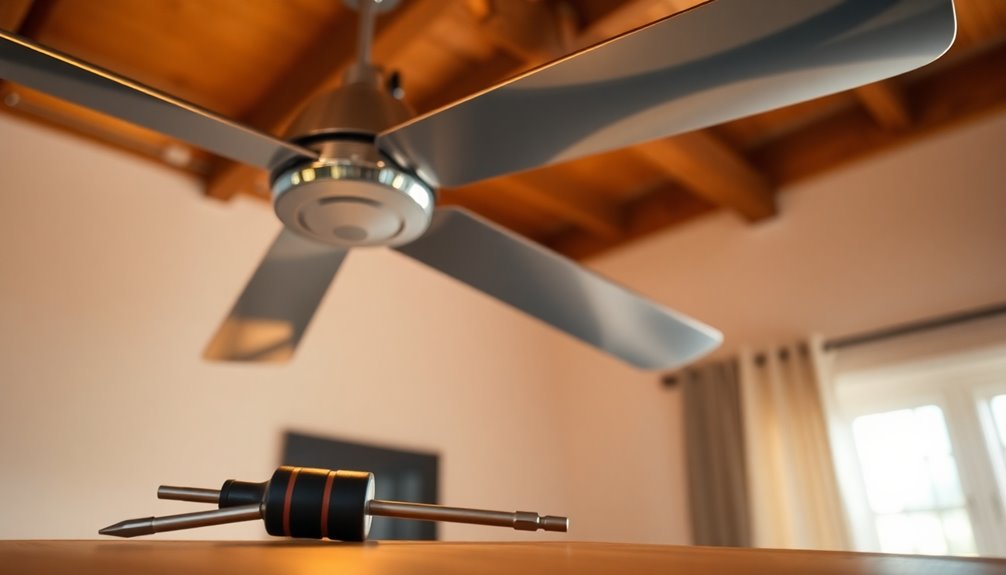
To keep your ceiling fan running smoothly, you should regularly check the light bulbs and replace them as needed to avoid flickering.
Don't forget to inspect the remote control batteries at least once a year to guarantee they're functioning well.
Additionally, take time to check the wiring connections to prevent any loose components that could lead to issues down the line.
Regular Bulb Checks
Regular bulb checks are essential for keeping your ceiling fan functioning smoothly and efficiently. By regularly inspecting your light bulbs, you can identify faulty bulbs that may cause flickering or trigger unexpected fan activation.
Here are three key practices to follow:
- Routine Maintenance: Schedule regular checks every 6 to 12 months to inspect your ceiling fan's light bulbs. This helps to minimize malfunctions and guarantees that bulbs are replaced as needed.
- Monitor Performance: After replacing any light bulbs, keep an eye on their performance. If you notice any recurring issues, like flickering, it might indicate deeper electrical problems that need addressing.
- Log Replacements: Maintain a record of bulb replacements and any issues observed. Tracking patterns can give you insight into potential problems, guaranteeing the longevity and reliability of your ceiling fan.
Remember to always use replacement bulbs that are compatible with your fan's specifications to avoid electrical issues.
Remote Battery Replacements
Keeping your ceiling fan in top shape goes beyond checking light bulbs; remote control batteries also play an essential role in its performance. Regularly check and replace your remote batteries every 6-12 months. This guarantees peak performance and prevents unexpected activation due to low power.
To help you manage battery replacements effectively, consider the following table:
| Task | Frequency |
|---|---|
| Check battery condition | Every 6 months |
| Replace batteries | Every 12 months |
| Dispose of old batteries | As needed |
Using high-quality batteries recommended by the manufacturer is important for compatibility and longevity. It's smart to keep a spare set on hand, allowing you to address any sudden remote failures quickly. Additionally, mark a calendar reminder for battery replacements to maintain a consistent maintenance schedule.
When disposing of old batteries, always follow local regulations to minimize environmental impact and guarantee safety. By implementing these preventive maintenance tips, you'll enjoy a hassle-free ceiling fan experience while contributing to a greener planet.
Wiring Inspections
Every six months, inspecting the wiring connections in your ceiling fan is essential for maintaining its performance and safety. Loose or damaged wires can lead to an intermittent power supply, causing your fan to operate unexpectedly.
Here are three key steps to guarantee your fan's wiring is in good shape:
- Check for Loose Wires: Make sure all wire nuts and connectors are securely fastened. Loose wires can disrupt electrical connections and pose safety risks.
- Inspect for Wear and Corrosion: Look for any signs of wear, corrosion, or damage on the wiring. These issues can compromise the integrity of electrical connections and lead to malfunctions.
- Use a Voltage Tester: To confirm that power is being properly supplied to the fan, use a voltage tester. This simple tool helps identify wiring issues before they escalate into serious problems.
Additionally, ensure that your fan is not exhibiting any clicking noise symptoms, which may indicate mechanical failure or loose components. If you feel uncomfortable inspecting the wiring yourself, don't hesitate to consult a professional electrician. They can perform thorough inspections and repairs, guaranteeing the safety and functionality of your ceiling fan.
Regular routine maintenance will help keep your fan running smoothly for years to come.
When to Call a Professional
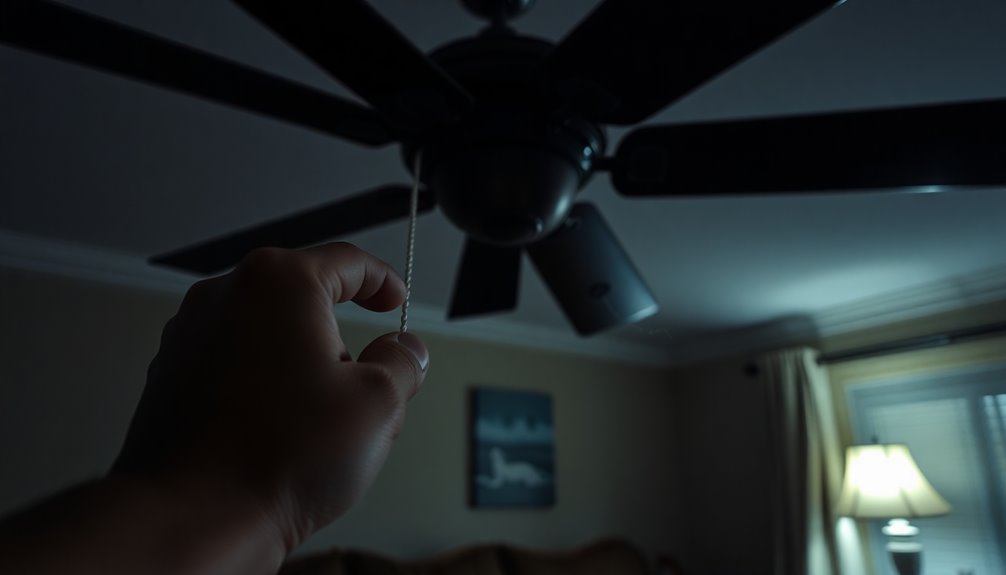
If your ceiling fan starts acting like it's possessed, it might be time to call a professional. Persistent issues could signal an underlying electrical issue that only an expert can address. Here are some signs indicating you should seek professional help:
| Signs to Call a Professional | Description |
|---|---|
| Burning Smells | Indicates potential wiring problems. |
| Frayed Wires | Signals electrical damage and safety risks. |
| Frequent Power Surges | Suggests larger electrical issues at play. |
| Difficulty Accessing Wiring | Can lead to injury if not handled correctly. |
| Uncertainty About Installation | Guarantees compliance with safety standards. |
If you notice any burning smells or frayed wires, don't hesitate to reach out for assistance. Additionally, frequent power surges affecting multiple devices might require an expert evaluation to prevent serious hazards. Remember, if you're unsure about proper installation or repairs, consulting a professional is wise. They'll guarantee your ceiling fan operates safely and efficiently, adhering to all safety standards while addressing any wiring issues. Your safety is paramount, so don't take risks when it comes to electrical work.
Understanding Ceiling Fan Technology
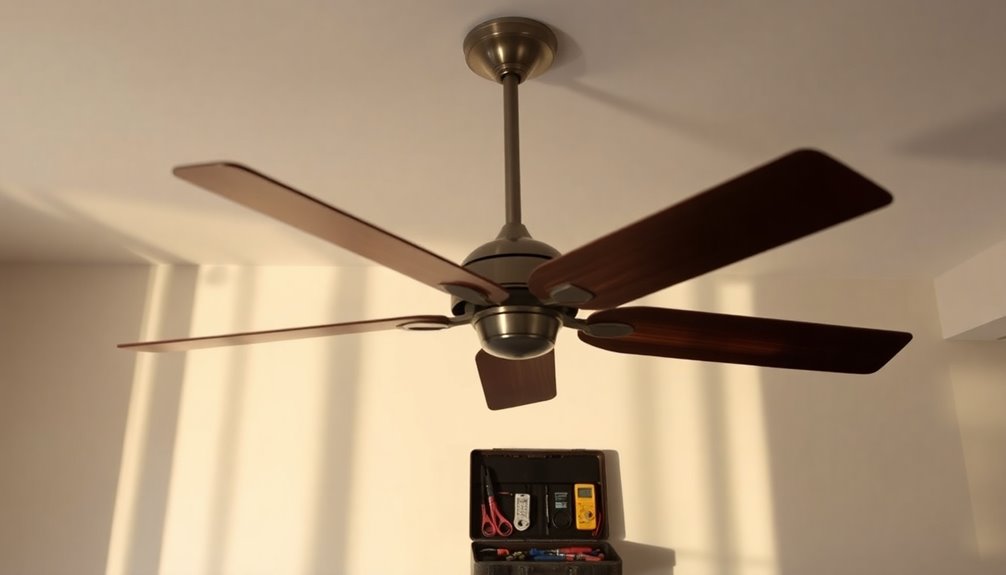
Understanding the technology behind ceiling fans can enhance your experience and help you make informed decisions about their use and maintenance. Modern ceiling fans integrate smart technology, enabling features like remote control operation, scheduling, and home automation compatibility. This makes air circulation effortless and efficient.
Here are three key technology components to evaluate:
- Speed Regulation: Ceiling fans use capacitors and sensors to manage speed and direction. This responsiveness to user commands allows you to customize airflow as needed.
- Energy Efficiency: Today's ceiling fans are designed to be energy-efficient. They reduce electricity consumption while maintaining effective air circulation, contributing to lower utility bills.
- Motion Sensors: Some ceiling fans utilize motion sensors to detect presence and adjust operation accordingly. This not only enhances convenience but also promotes energy efficiency by ensuring the fan runs only when needed.
However, keep in mind that using multiple remote controls can lead to signal interference from nearby devices.
Understanding these technological aspects can optimize your ceiling fan experience, ensuring you get the most out of its features while maintaining a comfortable environment.
Safety Considerations
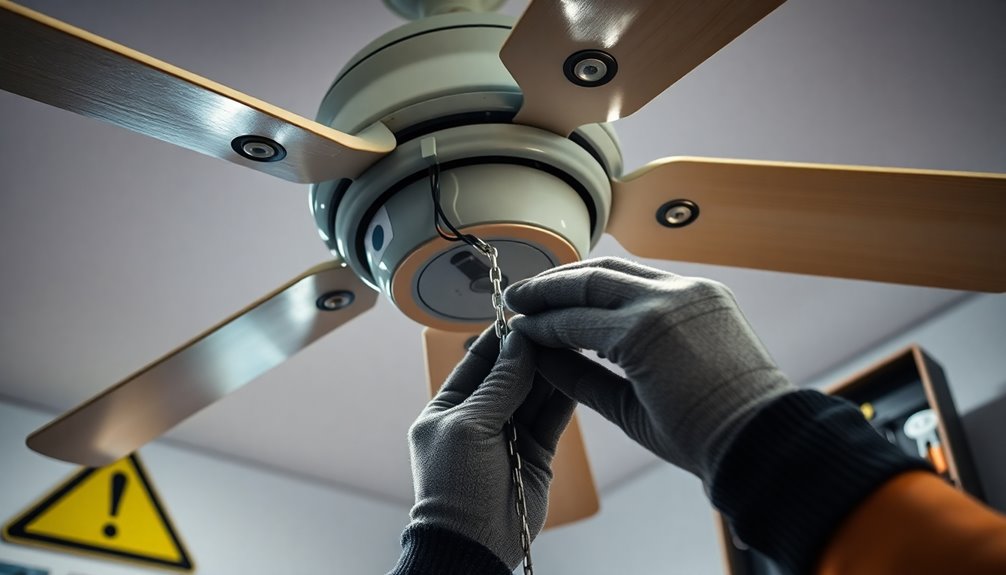
When working on your ceiling fan, safety should always be your top priority. Before you start any inspection or repair, make certain to turn off the power supply at the circuit breaker. This simple step can prevent electrical shock and guarantee a safer working environment.
When accessing high-mounted ceiling fans, use stable ladders and safety gear to avoid falls or accidents. Regularly check for proper grounding to minimize the risk of electrical hazards. A well-grounded fan is essential for safe operation, as it guarantees the fan is properly connected to your home's electrical system.
If you notice signs of malfunction, like flickering lights or unusual sounds, discontinue use immediately. Continuing to operate a faulty fan can lead to fire hazards. In such cases, it's best to err on the side of caution.
For complex electrical issues or if you're unsure about handling repairs, consider hiring a professional electrician. They can address wiring concerns and guarantee compliance with local safety codes.
Taking these precautions not only protects you but also prolongs the life of your ceiling fan.
Related Ceiling Fan Issues
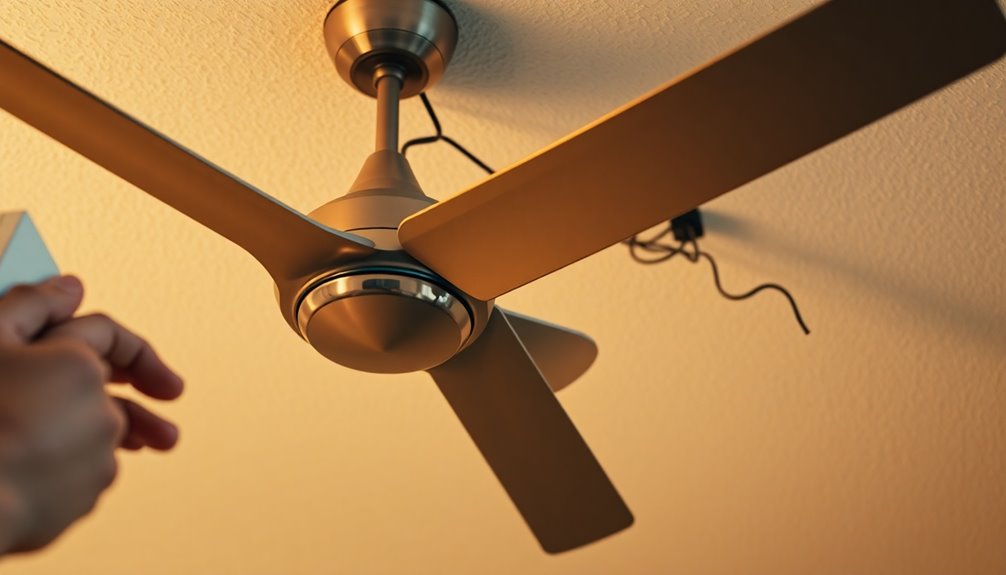
Ceiling fans can sometimes present a range of issues that disrupt their performance and efficiency. If your ceiling fan turns off unexpectedly or operates erratically, it might be due to various underlying problems. Here are a few common issues to take into account:
- Electrical Fluctuations: Power surges or faulty wiring can cause your fan to turn off or malfunction. Inspect for loose connections to guarantee stable electrical flow.
- Light Fixtures: If your ceiling fan is connected to light fixtures, malfunctioning components can affect overall operational performance. Make sure bulbs are functioning properly and connections are secure.
- Noise Issues: Buzzing or rattling sounds often indicate problems with the motor or wiring. These noise issues may signal that your fan needs maintenance or repair to restore proper function.
Additionally, improper installation can lead to random activation or failure to turn on.
Regular maintenance, including checking wiring and verifying everything is correctly installed, can prevent these common ceiling fan problems. By addressing these related issues, you can maintain your ceiling fan's efficiency and longevity.
Frequently Asked Questions
Why Is My Ceiling Fan Turning on by Itself?
If your ceiling fan's turning on by itself, it could be due to several reasons.
You might've remote control interference from nearby devices, or there could be a power surge affecting its operation.
Check for a malfunctioning pull switch or loose wiring connections, as these can cause random activation.
Environmental factors, like overheating motors or faulty sensors, could also be triggering it, so a thorough inspection is essential to identify the issue.
Why Does My Ceiling Light Turn on by Itself?
If your ceiling light's turning on by itself, you might want to check for a few common issues.
Interference from nearby remote controls can trigger it unexpectedly. Faulty switches or wiring can also be culprits, causing connectivity problems.
Additionally, power surges in your electrical system could activate the light autonomously.
Finally, consider whether aging bulbs or environmental factors might be affecting your light's behavior.
A simple inspection can help you identify the cause.
Why Does My Hunter Ceiling Fan Turn on and off by Itself?
If your Hunter ceiling fan turns on and off by itself, it could be due to a few issues.
You might've a faulty remote control or interference from nearby devices. Loose wiring connections can also disrupt the power supply, leading to erratic behavior.
Additionally, overheating motors or power surges may activate the fan unexpectedly.
Regular maintenance checks can help identify and prevent these problems, ensuring smooth operation of your fan.
Can You Reset a Ceiling Fan?
You'd think resetting a ceiling fan would be as simple as flipping a switch, right? Well, it can be!
To reset your fan, just turn off the power at the circuit breaker or unplug it for at least 30 seconds. Once you turn it back on, check for any reset buttons on the motor or remote.
This process can help it work better and last longer, so don't skip it!
Conclusion
In the world of ceiling fans, unexpected activation can feel like a surprise party you never wanted. By understanding the common causes and following the troubleshooting steps outlined, you can regain control over your fan's behavior. Remember to keep up with preventive maintenance to avoid future surprises. If all else fails, don't hesitate to call in a professional. With a little effort, you can guarantee your fan stays in check, bringing comfort and coolness without the drama.
